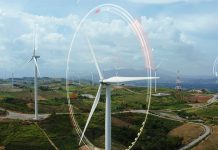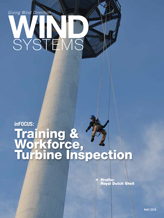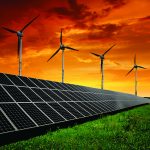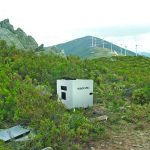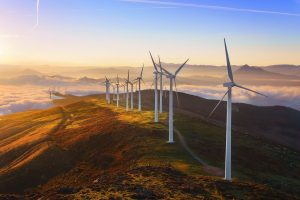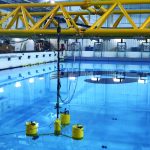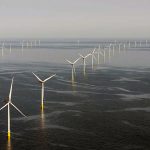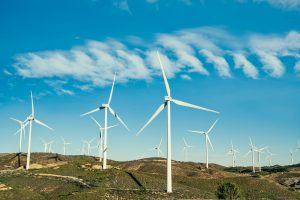Since Block Island Wind Farm off the coast of Rhode Island started generating power at the end of 2016, several states are building up their offshore wind capabilities in a move that could make the United States the next major player in the global offshore wind market.
But U.S. offshore wind faces some challenges in order to make that happen.
“A major issue for every industry entering a new market is the supply chain,” said Tim Fischer, vice director of the global wind division for Ramboll, one of the world’s leading wind consultants. “And the biggest question is: What is the U.S. market going to make of it?”
As of now, the infrastructure that would support a supply chain for offshore wind remains a hurdle in many places where the industry has the potential to grow.
The U.S. has a significant number of waterfront facilities, but many of them are already heavily in use from other industries or they suffer from aging infrastructure.
“The U.S. has a very robust supply chain in other industries such as oil and gas and the use of steel in manufactured products,” said Jay Borkland, senior managing consultant with Ramboll’s Environment & Health division. “That is obviously a strong basis on which to launch an offshore wind supply chain in the U.S. But one has to remember that it’s not the exact same product and production process. There’s a timeline — and investments that need to be made — in order to get the supply chain up and running for offshore wind.”
Upgraded facilities
For other links in a potential supply chain, facilities would need to be upgraded and modified in order to serve offshore wind, according to Borkland.
“A wind farm is not the same as building washing machines,” he said. “We need to adjust and adapt manufacturing capabilities to be able to produce the components that are needed for offshore wind. But that’s going to take some concerted effort, and there’s a timeline. Hopefully the strategy for the U.S. market will be a blended approach, initially with the U.S. supply chain developing as the industry develops and as more wind farms come online. And, importantly, what the supply chain needs is a pipeline of projects — that will signal the industry that it (offshore wind) is consistent.”
According to Fischer, local markets in Europe focused on their own supply chain, and they were open to supply. In order to get a supply chain started in the U.S., the approach can’t be tackled hastily.
“I’m very curious on what strategy will be taken, and I hope that it will be to build up the U.S. supply chain slowly,” Fischer said. “We do not expect it to be there from the start. The projects in the U.S. are quite big, and everyone wonders where the components will come from. So hopefully there will be a nice smooth transition from allowing supplies from other countries and ramping up to manufacturing components in the U.S. But it could take time. And that is also some of the parallels we can see in some European markets.”
East Coast States
But there has been much progress among several East Coast states such as Massachusetts, New York, and New Jersey.
Massachusetts was an early adopter of offshore wind with its Cape Wind project in Cape Cod. That project served as an icebreaker of sorts where all the activities associated with permitting and locating a wind farm were tackled, including integrating with agencies such as the Bureau of Ocean Energy Management, the Department of Energy, NOAA, and the National Marine Fisheries.
“So, Massachusetts has had a very robust history with offshore wind,” Borkland said.
And now Massachusetts has developed a program for larger wind projects that will be farther off the coast. That includes leases acquired by three large offshore wind developers that now have power purchase agreements being bid on by those major players, according to Borkland. And Massachusetts is prepared in terms of understanding the framework needed to both characterize the sites in offshore wind and the permitting process, as well as involving large stakeholders that include the fishing industry and the shipping industry.

“Massachusetts has undertaken a large number of studies in these outreach areas in an attempt to provide a platform for offshore wind developers as they are looking at developing their leases,” he said. “In addition to that, Massachusetts has invested in infrastructure.”
That first bit of infrastructure that related to wind was the creation of the Wind Technology Test Center (WTTC).
“The WTTC was constructed by the Massachusetts Clean Energy Center,” Borkland said. “The fact that Massachusetts has a Massachusetts Clean Energy Center is a plus. It is a state economic development agency entity that is directly involved in promoting renewable energy, including offshore wind. And it has a platform in which to develop assets for offshore wind. The WTTC is a wind-blade test center, and it was one of the largest in the world.”
With blades getting larger all the time, Borkland admits that there may more than likely be similar large test centers in development somewhere in Europe or Asia, but the WTTC still stands as a major achievement and continues to test blades for offshore wind.
Infrastructure
The bottom line of all Massachusetts’ myriad of studies came down to a not-so-surprising conclusion: the importance of infrastructure.
“There weren’t any ready-made port facilities that could assist in pure wind projects in the U.S., and so MassCEC studied this challenge to identify locations; and they identified a location in New Bedford, Massachusetts, as the best location in Massachusetts for an offshore wind port facility,” Borkland said. “And the state invested pretty significantly in the development of the first offshore wind port facility in the United States built specifically for offshore wind. I was fortunate to have been a part of the design team for that project, and a lot of mine and Ramboll’s interface with the supply chain had been developed through our relationship with the Clean Energy Center in Massachusetts, and the work that MassCEC did to pave the way for offshore wind there.”
New Jersey’s offshore wind journey has run along similar timelines where New Jersey recently made commitments to purchase more than 3,000 MW of offshore wind.
And New York has been thinking of offshore wind for some time with several initial projects.
“They have a major lease that BOEM has let,” Borkland said. “They have a competition for power. They have made a commitment for 2,400 MW of power purchase. And they are in the process of developing their own studies.”
New York also has completed a port study through the New York State Energy Research & Development (NYSERDA).
“They are moving along quite quickly and attempting to accelerate because they have a goal of a high percentage of power generation from renewables, including offshore wind, and they have targets for 2030 and 2050 that are aggressive — and therefore they are looking to have a quick process to bring those technologies online,” Borkland said.
Onshore vs. Offshore
Even though there is plenty of land that can still be used for onshore wind facilities, the reality of the situation is that the coastal areas of the U.S. are where the majority of power users operate.
“Consumer centers are on the coastline; therefore, it also makes sense to have energy where the consumer sits,” Fischer said.
Plus, the size and scale of offshore wind isn’t constrained by land issues; however, onshore wind can operate in tandem with offshore — as well as other renewable energy sources — in what is known as sector coupling, according to Fischer.
“That is how you can ensure a transition to green energy like Denmark,” he said. “(Denmark) is almost 100-percent green energy, and it’s because they combined all these different energy sources. Offshore wind is just one important part.”
A symbiotic relationship among supply chains is also key, along with project development, according to Borkland.
“I think one of the things that is propelling offshore wind as a concept, particularly in the northeast of the United States, is that the wind resource is tremendous off the coast,” he said. “It’s not just tremendous in terms of the strength and the size of the wind resource, but also the fact that it is reliable — essentially the wind blows all the time.”
So, there are less concerns about peak periods in terms of power production, and the potential of generating massive amounts of power from offshore wind would also serve to offset aging traditional energy sources such as oil, coal, and nuclear that will eventually have to fall off the grid, according to Borkland.
Offshore technology
The technology to efficiently implement offshore wind exists, but it’s going to take serious investment to capitalize on it, according to Fischer. And part of that includes building a workforce capable of constructing the large turbines needed.
“One of the things I see as both a very large challenge and a great opportunity in the U.S. marketplace is the idea of logistics, and (loosely) how logistics is related to development of the supply chain – and the development of the infrastructure and the actual development of the wind farms,” Borkland said. “And if you look at Europe as a model, the supply chain and the infrastructure developed hand-in-hand, and the industry formed in very large hub-type systems where a series of port facilities and infrastructure systems grew up where a lot of the manufacturing, fabrication, marshalling, and component-transfer out to the wind farm sites occurred at some very large, well developed facilities.”
However, in the United States, it’s different.
Borkland said there are few coastline locations where there is unused land or sufficient facilities that could be used or converted for offshore wind that don’t already compete with other kinds of shipping.
“And so, what’s likely to happen in the U.S. is the development of a network of facilities for manufacture and marshalling, fabrication, and assembling components for offshore wind,” he said. “And that large number of smaller facilities is going to require a network of logistics to sew it all together and make it work appropriately.”
Logistics issues
That includes everything from training facilities for specialized welders, to the development of specialty marine vessels and transfer barges to move components from site to site, according to Borkland.
“That’s something that did develop in Europe, but it needs to develop in the U.S. in its own way,” he said. “And I think there’s a large opportunity for existing U.S. service firms, as well as manufacturing firms, to get involved in solving the logistics issues that are going to occur in the U.S. because, quite frankly, the U.S. implementation of offshore wind is going to be a little bit different than the way Europe evolved.”
And that is because some of these turbine components are so massive, they can’t be handled the same way other manufacturing components are traditionally handled, according to Borkland.
“In particular, the Gulf of Mexico may be used to sending pieces of giant oil derricks offshore, but there’s nowhere on the U.S. East Coast where those kinds of components have been manufactured and routinely shipped,” he said. “And so, the onset of offshore wind is going to necessitate the development on the East Coast of that sort of infrastructure that can allow for those types of components. And it’s similar to what the Gulf of Mexico has developed in terms of how they service, say, the oil industry, but it’s also different in that the components are shaped differently, they require different handling, and in some cases, they’re larger.”
There’s also adaptive reuse of existing vessels as well as the potential for the development of new vessels and new equipment, according to Borkland.
The West Coast
The potential for new technology will also come into play when it comes to establishing offshore wind on the West Coast, where the continental shelf is not as broad.
“The Pacific has a similar population density along the coastline, and it has a good resource in terms of its wind resource,” Borkland said. “Its main challenge is that the water depth plummets very quickly offshore. The technologies to allow offshore wind foundations to be in place need to be developed and made more robust. A large percentage of the industry is promoting the concept of floating offshore wind turbines as the technology of choice for offshore wind for the West Coast. And there is a lot of development going on there. We’re not the first ones to think of floating offshore wind.”
Fischer said a lot of headway has been made in Europe in the development of floating turbines over the last five to eight years.
“In the U.S., there’s a really big market for this technology,” he said. “On the West Coast, you need floating technology because the water is too deep. And the U.S. could simply become the frontrunner for that technology globally.”
Next Steps
But for the immediate future, the East Coast is ripe for offshore wind development, and Borkland said he feels BOEM is also thinking along those lines quite aggressively as well.
“We know that, in addition to the Massachusetts leases already let and upcoming, BOEM is looking at New York, and New York is requesting that BOEM look at additional lease areas off of New York,” he said. “I think we’ll see another round of leasing and potentially new developers and new names that have not yet been involved in offshore wind in the U.S. getting involved in some of those new potential lease areas, and the projects will start to expand geographically down the coast.”
And that increased interest will align the Northeast states along a more reliable trajectory toward successful projects, which could affect the entire East Coast, according to Borkland.
“Some of the states that have been looking and watching the development of the resource move over the last several years are now beginning to come into the game,” he said. “And I think the geographic reach of offshore wind on the East Coast may literally extend from Maine to Florida eventually.”
For more information, go to www.ramboll.com


















